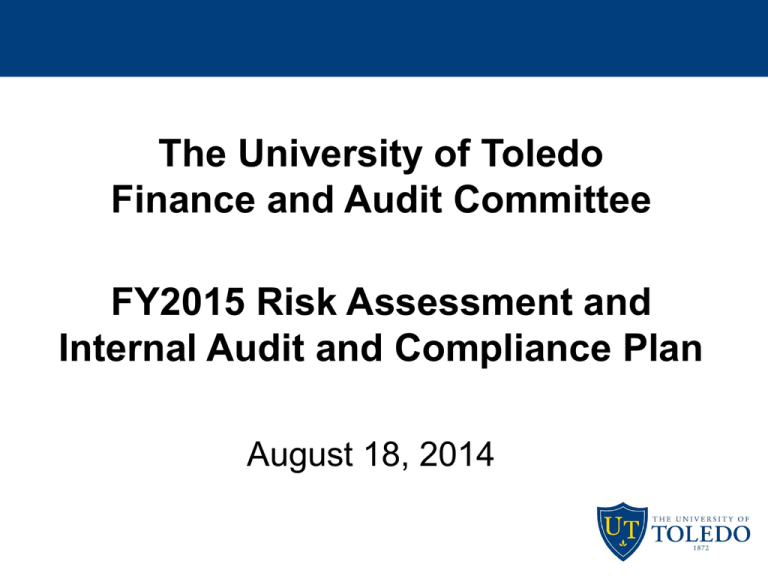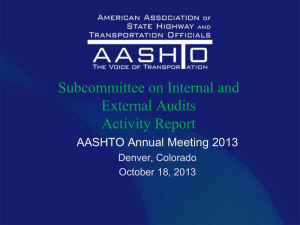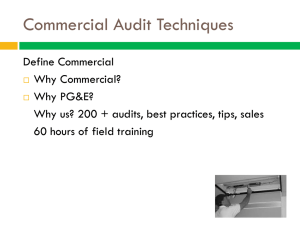FY2015 Internal Audit Risk Assessment
advertisement

The University of Toledo Finance and Audit Committee FY2015 Risk Assessment and Internal Audit and Compliance Plan August 18, 2014 FY2015 Internal Audit Risk Assessment KEY RISK AREAS ACADEMIC ENTRPRISE BUSINESS RISK PLANNED ACTIVITY PREVIOUS ACTIVITY • Is the University in conformance with all Federal regulations regarding the recruitment of overseas faculty? • Evaluate the effectiveness of procedures pertaining to the hiring of faculty by the Office of International Student Services. • Five-year audit cycle • First internal audit of this process • Process inconsistencies b/w campuses • Are research and development expenses expended in accordance with the terms of individual grants and State, Federal, and University regulations? • Review research grants procedures and test a sample of payroll expenses to ensure compliance with these procedures and external regulations. • • • • Three-year audit cycle Collaboration with Plante and Moran Financial conflict of interest issues Issues with ARRA grant reporting • Is financial aid awarded only to eligible students consistent with the terms of the various award programs? • Review student financial aid procedures and test a sample of loans to ensure that eligibility requirements are met and financial aid is disbursed accurately. • • • • Annual audit cycle Significant annual dollar throughput Collaboration with Plante and Moran Issues with financial aid disclosures • Is the University taking appropriate measures to maintain its academic credentialing? • Serve as a criterion leader for the upcoming Higher Learning Commission site visit. • Five-year audit cycle • Ability to assess resource allocation and federal compliance via HLC self-study • Are internal processes and computer systems designed to facilitate the student experience? • Support the UT student customer service initiative by evaluating current customer support systems and processes. • Annual audit cycle • Student housing, scholarships and aid • Textbook ordering, bookstore issues, etc. • Does the research and innovation division of the University conduct its financial business in a responsible and transparent manner, consistent with appropriate accounting principles? • Review financial transactions of the University of Toledo Innovation Enterprises. Ensure that appropriated amounts were used for their intended purposes. • • • • • • Does the University’s governance structure promote compliance with applicable laws and regulations for both the academic and clinical enterprises? • Conduct a risk assessment of all aspects of institutional compliance to include (but not be limited to): capital projects, facilities, contracts, healthcare, human resources, labor relations, and research. • Annual audit cycle • Project will form the basis for a UT enterprise risk management framework. 2 Annual audit cycle Finance and Audit Committee request Previous governance issues Recent change in leadership Possible conflict of interest issues FY2015 Internal Audit Risk Assessment KEY RISK AREAS BUSINESS RISK PLANNED ACTIVITY CLINICAL ENTERPRISE • Is UTMC taking appropriate steps to ensure compliance with Joint Commission accreditation standards on an ongoing basis? • Review Joint Commission standards, determining whether effective UTMC problem identification/resolution procedures are in place relative to these standards. • • • • • • Is UTMC prepared for upcoming changes to coding of medical transactions? • Review system and documentation requirements to ensure readiness for future ICD-10 coding classifications. • Five-year audit cycle • Developed ICD-10 preparedness plan • Developed employee training plan • Are all billable hospital visits being captured in the revenue cycle, and at the correct rates? • Review professional fee coding for inpatient sites of service (University of Toledo Medical Center). • Annual audit cycle • Developed plan to increase coverage • Leveraging third-party expertise • Are all billable office and clinic visits being captured in the revenue cycle, and at the correct rates? • Review Current Procedural Terminology (CPT) codes and the related ICD-9-CM codes for clinic office visits (University of Toledo Physicians). • • • • Annual audit cycle Developed plan to increase coverage Leveraging third-party expertise Clinical Risk Assessment findings • Do the hospital and clinic computer systems under development promote a streamlined and secure process flow between the patient, Information Technology, and operating departments? • Participate in the various “Meaningful Use” new clinical systems development projects as a controls consultant and identify opportunities for system and process integration. • • • • • Five-year audit cycle Recommendations on transaction testing Verified project milestone achievement Improved new systems methodology Advised on project planning 3 PREVIOUS ACTIVITY Two-year audit cycle Independent assurance prior to site visit Self-assessment framework established HIPAA security and training issues Policy development issues FY2015 Internal Audit Risk Assessment KEY RISK AREAS BUSINESS PROCESS IMPROVEMENT BUSINESS RISK PLANNED ACTIVITY PREVIOUS ACTIVITY • Is the employee staffing and compensation process effective and efficient, produce reliable financial reporting, and comply with applicable laws ? • Lead a Control-Self Assessment of Human Resources, Talent Development, and Payroll business process, with emphasis on process redesign. Review employee dependent benefit eligibility. • • • • • Two-year audit cycle Changes in leadership Undocumented, non-standard processes Numerous employee overpayments Employee classification codes • Are all billable transactions captured at the time of inpatient diagnosis and fully reflected in customer bills? • Review the accuracy and reliability of the charge master databases, the charge capture process, and procedures for maximizing inpatient margins. • • • • Annual audit cycle High-dollar volumes and throughput High write-off rate Not billing certain types of transactions • Does the operation of the UTMC emergency room promote the appropriate level of effectiveness and efficiency of operations. • Conduct a process engineering review of emergency room operations with an eye toward increasing throughput, minimizing disruptions, and ultimately offering recommendations to improve patient satisfaction as a result of improvements to the process. • • • • • • • Five-year audit cycle First Internal Audit & Compliance review High-margin transactions High-cost equipment and supplies Fast-paced environment Prone to waste, errors, inefficiencies Numerous service quality opportunities • Do internal business processes at University of Toledo Medical Center maximize effectiveness and efficiency of operations? • Establish a process engineering capability at the University, with an initial focus on the clinical enterprise. Conduct projects that are aligned with a Lean Six Sigma approach to process improvement. • • • • • • Annual audit cycle New University department/function Establish reengineering training program Reduce delays/wait times Schedule to cover all high-risk areas Specific projects to be announced 4 FY2015 Internal Audit Risk Assessment KEY RISK AREAS BUSINESS RISK PLANNED ACTIVITY PREVIOUS ACTIVITY INFORMATION TECHNOLOGY • Is information and software processed in the data center environment secured and protected? • Review IT “general controls”, such as information security and change control that impact numerous computer systems. • Annual audit cycle • Collaboration with Plante and Moran • Security and change management issues • Does the University comply with Payment Card Industry standards for network security when processing University credit card transactions at all locations? • Self-Assess security and application controls over the computer networks that process student and patient credit card transactions. Independently evaluate compliance with these controls. • • • • • • Are the University’s computer systems protected against unauthorized and unapproved attempts to obtain access? • Conduct an independent and objective test of the vulnerabilities of the University’s academic and clinical information systems (system penetration analysis). This would be accomplished using a combination of attempts to access the computer systems electronically and via “social engineering”. • • • • • • • Are changes made to the University’s healthcare information systems in a structured, controlled manner, that supports authorizations, approvals, testing, documentation, and end user engagement? • Determine the effectiveness of change management procedures within the University of Toledo’s healthcare informatics environment. • • • • • 5 Two-year audit cycle Developed University PCI policy Developed PCI compliance procedure Procedure to vet PCI-compliant systems Process to secure network infrastructure Two-year audit cycle Finance and Audit Committee request Now required as part of PCI standards Recent email “phishing” incidents Benchmark to Ohio public universities Most peer institutions have already performed at least one • Partnership with independent, objective third-party subject matter expert Three-year audit cycle Systems development methodology Information security issues Software change management issues Relationship with software vendor FY2015 Internal Audit Risk Assessment KEY RISK AREAS BUSINESS RISK PLANNED ACTIVITY ATHLETICS • Are revenues and expenses pertaining to intercollegiate athletics accounted for properly according to National Collegiate Athletics Association (NCAA) rules and University policy? • Evaluate the quality of financial controls over athletic student aid; guarantees; support staff/administrative salaries, benefits and bonuses paid by the University and related entities; and recruiting. • • • • • • Annual audit cycle Collaboration with Plante and Moran Reporting to Ohio Auditor of State Compliance with NCAA rules Past financial reporting issues Monitoring of actual & budget variances • Is University contact with prospective student-athletes in accordance with NCAA regulations, and is it being monitored accordingly and appropriately for all team sports? • Review phone, email, Internet, and letter correspondence between coaches, administrators and prospective studentathletes on a surprise basis. Report results and monitor corrective action. • • • • • Three-year audit cycle Contact with prospective student-athletes Consistent monitoring for all team sports Contact in all forms with student-athletes Ongoing testing and remediation • Do student-athletes meet all applicable academic eligibility requirements, and if the student does not, are they prohibited from representing the University in intercollegiate athletics competition? • Determine the level of compliance with NCAA regulations pertaining to academic and general requirements. These include general eligibility requirements, seasons of competition, freshmen academic requirements, progress-toward-degree requirements, transfer regulations, high school all-star games, and outside competition. • • • • • • • • • Three-year audit cycle Student-athlete, Athletics responsibilities Meeting academic eligibility requirements Processing of violations Prohibition from athletic competition Compliance with NCAA regulations Academic and general requirements Eligibility, competition, freshmen Degree requirements, transfers, etc. • Do student-athletes receive only those benefits permissible under NCAA regulations? • Evaluate the process for granting scholarships to student-athletes. Ensure that scholarships/academic awards contain only those benefits that are acceptable under NCAA rules. • Three-year audit cycle • Only NCAA-permissible benefits • Athlete scholarships and financial aid 6 PREVIOUS ACTIVITY FY2015 Internal Audit Risk Assessment KEY RISK AREAS BUSINESS RISK PLANNED ACTIVITY AMERICANS WITH DISABILITIES ACT COMPLIANCE • Does The University provide reasonable accommodations to students that have a form of disability? • Progress the University’s Americans with Disabilities Act compliance program, which includes a comprehensive series of audits to evaluate academic accommodations. • • • • • Annual audit cycle Student Disability Services function Granting required ADA accommodations Services to students Support to faculty • Does the University provide reasonable accommodations to patients that have a form of disability? • Progress the University’s Americans with Disabilities Act compliance program, which includes a comprehensive series of audits to evaluate facilities and facilities transition plans. • • • • • Annual audit cycle Incorporating ADA in UT facilities policies Ensure new facilities are ADA compliant Develop a plan for older facilities Evaluate progress toward the plan • Does the University take all necessary steps to eliminate barriers in information technology, to make available new opportunities for people with disabilities, and to encourage development of technologies that will help achieve these goals? • Progress the University’s Americans with Disabilities Act compliance program, which includes a comprehensive series of audits to evaluate distance learning and Web accessibility. • • • • • • • Three-year audit cycle Assistive Technology Specialist function Online course development Internally-facing websites Externally-facing websites Web-checking for ADA compliance Faculty and staff training • Has the University of Toledo Medical Center developed a plan to ensure Americans with Disabilities Act compliance in all its forms, and is it progressing this plan? • Progress the University’s Americans with Disabilities Act compliance program, which includes a comprehensive series of audits to evaluate compliance of the clinical enterprise. • • • • • Annual audit cycle Clinical facilities transition plan Accessible pathways Process for requesting accommodations Services to patients, families, and staff 7 PREVIOUS ACTIVITY








